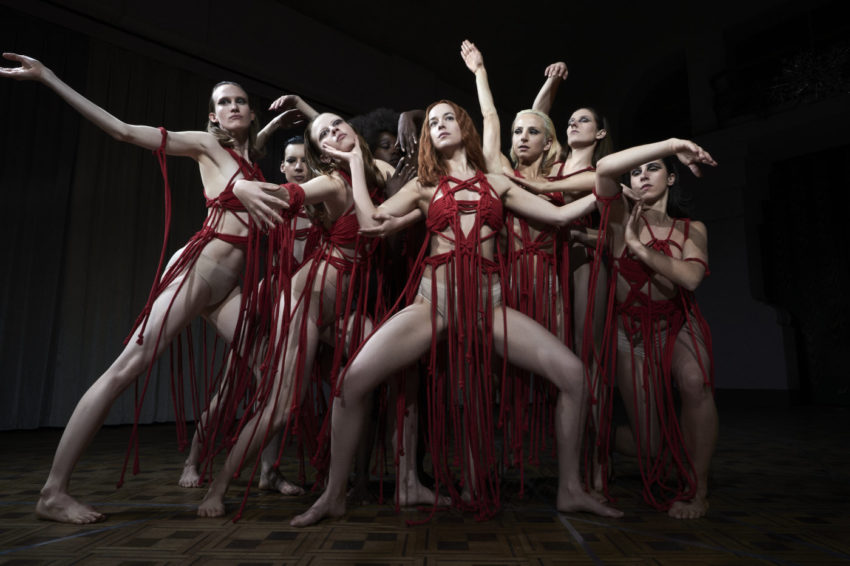Film Review: Suspiria

A remake of Italian ‘horror maestro’ Dario Argento’s Suspiria has been on the cards for years, and here it receives the most extreme and epic of treatments by producer/director Luca Guadagnino, who crams the thing with gratuitous violence and even more gratuitous art.
Pushed into production quickly after Guadagnino’s Call Me By Your Name, it’s drawn from one of the great Eurohorror movies of the 1970s (which was co-written by Argento’s then-partner Daria Nicolodi, mother of #MeToo key player Asia Argento) so you rightly expect it to be wild and outrageous, but Luca (not one for subtlety or brevity) ups the wildness and outrageousness to such a pitch of hysteria that it’s almost tedious at times.
Divided pointlessly and pretentiously into six acts, this opens in 1977 (the year of the original’s release) with Patricia (Chloë Grace Moretz), a student at the Markos Dance Academy in Kreuzberg in West Berlin, raving to her elderly psychotherapist Josef Klemperer about crazy dark magic stuff. The credits list Josef as being played by ‘Lutz Ebersdorf’ and the player’s identity was a secret for a time, but it’s so obviously someone famous under rubbery make-up that you’ll wonder why they bothered.
We then meet Susie Bannion (Dakota Johnson from Guadagnino’s A Bigger Splash), an Ohio dancer with a Mennonite background (?) who’s somehow (?) been accepted into studying at the Academy by lead choreographer Madame Blanc, and she’s played by Tilda Swinton in her fifth film for Guadagnino. Creepy and bizarre things are afoot right from the word go, and the streets outside are full of pro-Baader-Meinhof protests and terrorist bombings (none of which have anything to do with the first Suspiria), so you therefore can’t help but ponder why Susie would happily stay at the place and not run screaming to the American embassy. And yet so little here makes sense that you almost accept it.
Susie becomes friendly with fellow student Sara (Mia Goth from Lars von Trier’s Nymphomaniac double-header) and later tries it on with Madame Blanc, which allows for some leering lesbian overtones, and soon we get down to supernatural business as it’s revealed (as if somehow you didn’t know) that the Academy is a front for a coven of seriously powerful and malevolent witches. Why exactly would you try and hide from the world while running a dance school full of international students though? Good question!
The witches are an awfully evil bunch, and while Guadagnino probably thought he was sidestepping the misogyny of Argento’s films, there’s such an emphasis on torn-apart female bodies here, as well as the aged and the abject, that such noble intents pretty much go to Hell. Luca also wants to tick all the boxes by casting cult stars as some of the maleficent mob: Renée Soutendijk from Paul Verhoeven’s The 4th Man is in there, while Ingrid Caven, former wife and muse of late great German auteur Rainer Werner Fassbinder, hopefully encourages oh-so-lofty comparisons between this and pics like The Bitter Tears Of Petra Von Kant and (fittingly) Fear Eats The Soul.
Just about an hour longer than the 1977 film (at 152 minutes), this is also, none too surprisingly, even more graphically violent than that one, with the first sequence of real horror and cruelty (which almost recalls a bit in the last Final Destination) setting the nasty tone, until we get to the final act and a near-ludicrous symphony of exploding heads and yanked-out guts.
Despite the off-putting title, epic running time, gory unpleasantness and laughable expressive dance numbers, Guadagnino, his favourite screenwriter David Kajganich and others seem to think that this will be a hit, and as there are two sequels to the first Suspiria – namely Inferno (1980) and the longtime-coming and preposterous Mother Of Tears (2007) – that means that they might get around to remaking those too. And that’s bloody scary!